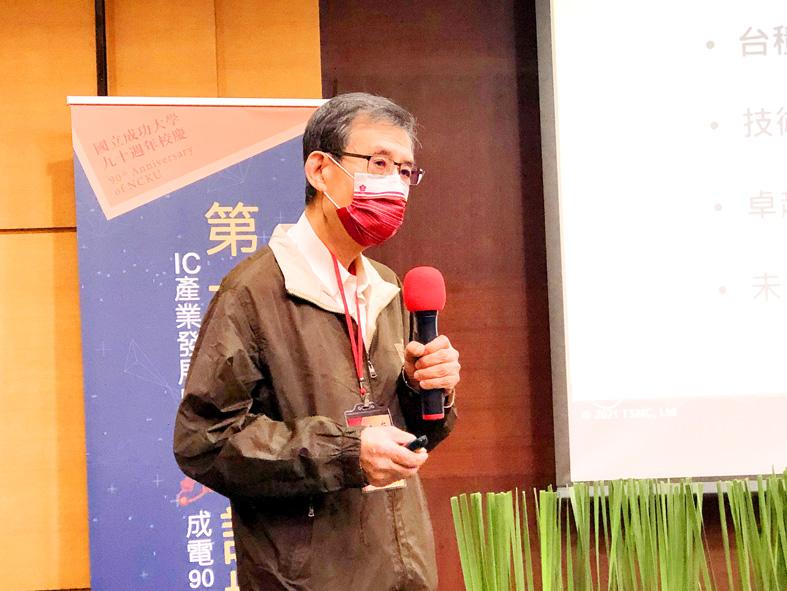Taiwan Semiconductor Manufacturing Co (TSMC, 台積電) yesterday said that it plans to roughly double its capacity expansion over the next three years to cope with rapidly growing demand for chips used in high-performance computing (HPC) applications and electronic devices.
The COVID-19 pandemic accelerated a global digital transformation as lockdowns led to a surge in demand for PCs and other devices that connect to the Internet, the Hsinchu-based chipmaker said.
Chip demand also rose due to increased usage of contactless payment tools and the growing popularity of electric vehicles, it said.

Photo: CNA
“We started speeding up our capacity expansion at the beginning of last year, but the semiconductor supply chain was still unable to catch up ... with demand growth,” TSMC senior vice president Y.P. Chin (秦永沛) told a semiconductor forum organized by National Cheng Kung University in Tainan.
Since then, a global semiconductor supply crunch has shown no signs of alleviating, Chin said, adding that supply constraints have been even worse lately because of component disruptions.
However, the supply chain disruption is just a short-term phenomenon, he said.
The key issue is how to cope with the voracious demand for chips used in HPC-related applications and electronic devices, with the trend fueled by digital transformation, he said.
TSMC said it expects the global semiconductor industry to show compound annual growth of more than 10 percent from this year to 2025, outpacing growth of 7 percent in the five years to last year and 3 percent from 2000 to 2015.
To seize this opportunity, TSMC is approximately doubling the pace of its capacity expansion from this year to 2023, compared with the three years to last year, Chin said.
The rapid expansion could widen the lead it has over its closest foundry competitor, Chin said, adding that TSMC’s total capacity last year was about three times greater than its rival’s foundry capacity.
TSMC on Tuesday unveiled new capacity expansion plans in Taiwan and Japan.
A new fab in Japan is to produce 22-nanometer and 28-nanometer chips, while a new plant in Kaohsiung is to focus on 7-nanometer and 28-nanometer chips, the company said after its board of directors approved a capital budget of US$9.04 billion.
Construction of the two fabs is scheduled to begin next year, with mass production expected to begin in 2024.
Taiwan has an advantage over other countries and regions in helping chipmakers to build cost-effective fabs, given its sound semiconductor ecosystem and supply chains, which took the nation 30 years to foster, Chin said.
“Although many countries consider semiconductor manufacturing to be a national security issue amid geopolitical tensions, it is not easy to make chips locally,” Chin said.
The semiconductor industry is capital-intensive, technology-intensive and labor-intensive, he said, adding that it might be easy for wealthy countries to raise capital to make chips, but a semiconductor ecosystem and supply chains cannot be created overnight.
“We are very optimistic about Taiwan’s semiconductor industry for at least for the next 10 years,” he said.
TSMC founder Morris Chang (張忠謀) last week said that it would “not ... be a possible task” to rebuild semiconductor supply chains in the US due to high costs.

A magnitude 7.0 earthquake struck off Yilan at 11:05pm yesterday, the Central Weather Administration (CWA) said. The epicenter was located at sea, about 32.3km east of Yilan County Hall, at a depth of 72.8km, CWA data showed There were no immediate reports of damage. The intensity of the quake, which gauges the actual effect of a seismic event, measured 4 in Yilan County area on Taiwan’s seven-tier intensity scale, the data showed. It measured 4 in other parts of eastern, northern and central Taiwan as well as Tainan, and 3 in Kaohsiung and Pingtung County, and 2 in Lienchiang and Penghu counties and 1

FOREIGN INTERFERENCE: Beijing would likely intensify public opinion warfare in next year’s local elections to prevent Lai from getting re-elected, the ‘Yomiuri Shimbun’ said Internal documents from a Chinese artificial intelligence (AI) company indicated that China has been using the technology to intervene in foreign elections, including propaganda targeting Taiwan’s local elections next year and presidential elections in 2028, a Japanese newspaper reported yesterday. The Institute of National Security of Vanderbilt University obtained nearly 400 pages of documents from GoLaxy, a company with ties to the Chinese government, and found evidence that it had apparently deployed sophisticated, AI-driven propaganda campaigns in Hong Kong and Taiwan to shape public opinion, the Yomiuri Shimbun reported. GoLaxy provides insights, situation analysis and public opinion-shaping technology by conducting network surveillance

‘POLITICAL GAME’: DPP lawmakers said the motion would not meet the legislative threshold needed, and accused the KMT and the TPP of trivializing the Constitution The Legislative Yuan yesterday approved a motion to initiate impeachment proceedings against President William Lai (賴清德), saying he had undermined Taiwan’s constitutional order and democracy. The motion was approved 61-50 by lawmakers from the main opposition Chinese Nationalist Party (KMT) and the smaller Taiwan People’s Party (TPP), who together hold a legislative majority. Under the motion, a roll call vote for impeachment would be held on May 19 next year, after various hearings are held and Lai is given the chance to defend himself. The move came after Lai on Monday last week did not promulgate an amendment passed by the legislature that

Taiwan is gearing up to celebrate the New Year at events across the country, headlined by the annual countdown and Taipei 101 fireworks display at midnight. Many of the events are to be livesteamed online. See below for lineups and links: Taipei Taipei’s New Year’s Party 2026 is to begin at 7pm and run until 1am, with the theme “Sailing to the Future.” South Korean girl group KARA is headlining the concert at Taipei City Hall Plaza, with additional performances by Amber An (安心亞), Nick Chou (周湯豪), hip-hop trio Nine One One (玖壹壹), Bii (畢書盡), girl group Genblue (幻藍小熊) and more. The festivities are to